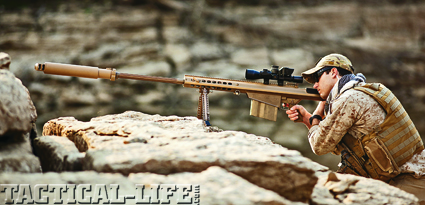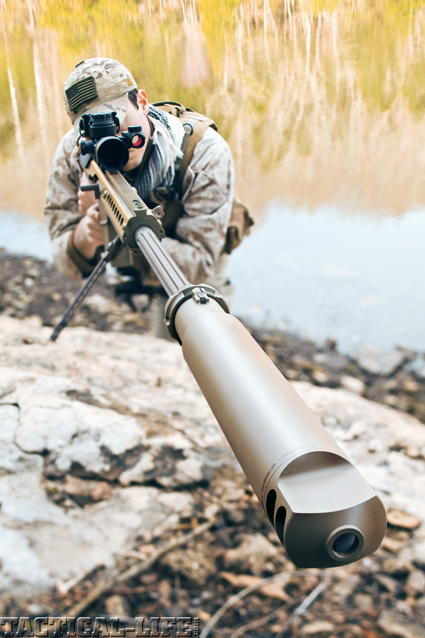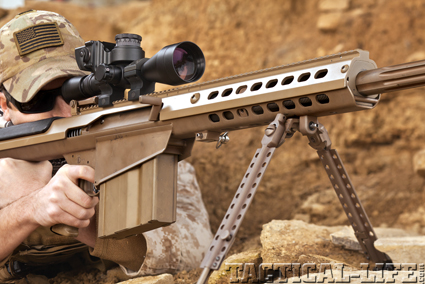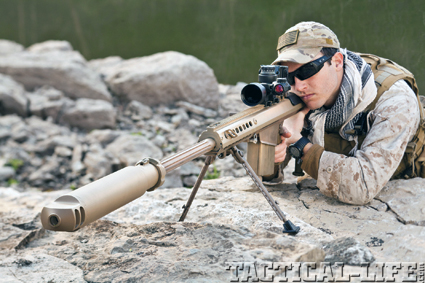Marine LCpl. Andrew Day puts the M107A1 through its paces. Day and fellow sniper, LCpl. Rory Carter, were fans of the reduced weight. The difference in gun weight would have meant an extra loaded mag or more water on missions in Iraq. Snipers can be rough on gear, so the M107A1’s new anti-corrosion coatings will extend service life in the harsh sandbox environment. And the color looks good, too.
Driven by the demands of combat Barrett engineers have redesigned every component of the M107A1 to be lighter yet stronger. The result is a high-performance rifle that weighs four pounds less than the original M107. But, far from being an abbreviated version of its bigger brothers, the M107 or Model 82A1, the Barrett M107A1 is every bit as tough.
Designed to be used with a suppressor, this one-of-a-kind rifle allows signature reduction capabilities with the flawless reliability of the original Barrett M107. An all-new bolt carrier group has been designed that is key to making the rifle suppressor-ready. Its titanium four-port muzzle brake is engineered to work seamlessly with a quick-attach Barrett .50 BMG Suppressor.
Advertisement — Continue Reading Below

Long, lean machine! An even lighter M107A1 will be available with a 20-inch CQB barrel, which will cut six pounds from the original M107’s total weight.
M107A1 At The Range
Itching to put this new rifle through its paces, the plan was to spend the day at my range with Barrett’s U.S. Military Sales Manager Kyle Lynch. To give it a thorough and experienced evaluation, TW invited LCpl. Andrew Day and LCpl. Rory Carter to join us. These two Marine snipers have fired thousands of rounds each from an M107 in training over the past six years, as well as during their combat tours in Iraq.
The weather that day was just above freezing. The wind was blowing south at 3 to 5 mph at the start of our shooting, then rising to 10 to 12 mph over a three-hour period. Our target was placed at 500 yards. The Marines’ extensive training and youth were evident when we compared targets, but, proudly, not by a large margin. A credit to the Barrett design, I was able to average 14.25 inches for five shots, or just under the 3-MOA rating for this weapon. These Marines averaged 11.75 inches for five shots, or 2.35 MOA. All shooting was conducted with Barrett M33 661-grain ammunition.
Advertisement — Continue Reading Below
Less Is More
“As far as being able to shed unnecessary weight, it’s awesome,” Rory Carter said. “In an all-out combat situation, you’re not only carrying the rifle itself, but you’re carrying the ammo and your primary weapon.”
Advertisement — Continue Reading Below
Andrew Day concurred with his friend: “I carried the M107 all through my tour in Iraq. The shedding of weight is a key feature. They [Barrett] shaved four pounds off the weight, and while a lot of people might not think much about it, pounds are pounds.”
“That’s an extra mag, if you think about it,” Carter interjected.
“Yes, and when you think about what you could have done with that extra four pounds, that’s another CamelBak of water that you can strap to you,” Day concluded.
Advertisement — Continue Reading Below
“As far as the recoil is concerned, it’s been drastically reduced,” Carter said. “It’s so much smoother of an action, and you don’t get that ‘punched in the nose’ feeling every time you shoot it.”
“The recoil seemed a lot more fluid than our M107s always have been,” Day said. “It was a lot easier to stay on target after the shot’s fired and it’s a lot easier to regain your sight picture.”
More Advantages
Our conversation turned to the new protective coatings on the M107A1. “The things that we discussed today about the anti-corrosion coatings, being able to take care of it better with a lot less maintenance is a plus,” Day said. “We’re Marines, so we’re going to take care of it no matter what,” he said with a chuckle, “but anything that can be done to make it last longer is a key feature because we’re really hard on them when in-country.”
Advertisement — Continue Reading Below
“The ability to put a suppressor on it is great, too,” Carter said of the M107A1.
Day shared more of his insights. “At first glance, the ability to put a suppressor on it didn’t really register with me, as to why. Even with a suppressor, it’s still a big stick; it’s still going to make some noise. Muzzle flash, keeping it down—that’s a huge advancement. With the operations that are conducted at night, that’s a real big advantage. Even during the day, we’re never sitting in the open sunshine. Ever. We’re always in a shadowed, very dark area, so anything we can do to give away less of our position is a huge tactical advantage.
“The suppressor provides an advantage for the shooter as far as where you choose to shoot the weapon, like back in a small room, out of the window, it’s going to be a very noticeable plus. It allows you to communicate with the people around you a lot easier.” Day continued, “I had an experience in Iraq where I blew my ears just completely out with an M107. I was spotting for my ATL, sitting next to a stone wall. In the heat of the moment, it didn’t register to put in an EarPro, and man, I wasn’t walking straight after he dropped off five rounds in rapid succession. It just blew our ears off.
Advertisement — Continue Reading Below
“A lot of times it’s just the price you pay in that kind of situation where you just do what you have to do. That’s when a suppressor would have helped my day go a lot better, and it would have been easier to sleep at night without that ringing.”
Carter added, “I do like the new compensator without the suppressor, too. It’s nice to be off on the side instead of being directly behind or on top of the shooter. And, I like the color,” Carter noted with a laugh, “you don’t have to spray paint it.”

The M107A1’s new integral muzzle brake, or the suppressor, reduces recoil and makes sight-picture recovery faster.
Advertisement — Continue Reading Below
New And Improved
“We were able to shave weight off this weapon by incorporating new extruded aluminum and titanium parts,” Kyle Lynch said. “What we’ve wound up with is an all-aluminum upper receiver, and the Picatinny rail is part of the extrusion of the upper assembly. We’ve incorporated titanium in the internals, the rear monopod and the bipod.”
“The internals of the M107A1 have been designed for use with a suppressor,” Lynch said. “We’ve redesigned the bolt and bolt carrier mechanism. It got a mechanical extension instead of a spring extension. This ensures that, with the additional weight of the suppressor on the muzzle of the gun, everything is timed properly so that the pieces are in sync. We also have a new buffer inside the receiver that keeps all of the reciprocating mass from going too far back and damaging the receiver.”
The lightweight aluminum upper receiver features an integrated, rigid 27-MOA M1913 Picatinny rail. Inside the upper receiver, the bolt carrier rides on a hardened steel, anti-wear strip for added durability. A thermal-guard cheek piece protects the user’s face from extreme heat or cold.
Advertisement — Continue Reading Below
Advanced design and manufacturing make the M107A1 more precise than ever. The rear barrel stop and front barrel bushing are bolted and bonded with a compound similar to that used on space shuttles. A titanium barrel key and fully chrome-lined bore and chamber add to the rifle’s durability.
Enhanced modularity is also a key feature. The rifle’s rail-mounted aluminum rear grip is easily reconfigured. The newly designed titanium and polymer monopod is easily adjustable from either side, as well.
The M107A1 rifle’s lower receiver includes a new aluminum recoil buffer system that’s optimized for use with a suppressor. The bolt carrier’s components are protected with a mix of ultra-hard PVD coatings and advanced nickel-Teflon plating that increases lubricity, is corrosion-resistant and greatly eases cleaning. Magazines also got a facelift for the M107A1. Numbered witness holes on the magazine help the shooter keep track of rounds in the rifle.
Later on in 2011, a 20-inch barreled M107A1 CQB version will become available to our soldiers. “The 20-inch version should really appeal to law enforcement agencies,” Lynch said. “The shorter length will be much easier to use in S.W.A.T. applications, and it will reduce the weight about six pounds from the M107.”
Take a look at these Top 12 .50 BMG Rifles!
























